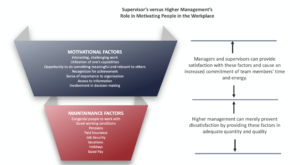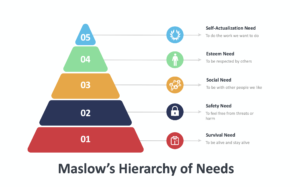One noted behavioral scientist, Frederick Herzberg, in his 2-Factor Motivation Theory (1959) made a distinction between job dissatisfaction and satisfaction.
He argues that Satisfaction for an employee comes from truly motivating factors such as interesting and challenging work, utilization of one’s capabilities, opportunity to do something meaningful, recognition of achievements, and responsibility for one’s own work.
Dissatisfaction occurs when the following factors are not present on the job: good pay, adequate holidays, long enough vacations, paid insurance and pensions, Good working conditions, and congenial people to work with.

Herzberg’s 2-Factor Motivation Theory
Herzberg bases these definitions on what is now known as the 2-Factor or the Motivation-Hygiene Theory. He says that every human being has two motivational tracks: (1) a low-level aspect, which is animal in nature and bent only on surviving, and (2) a higher-level aspect, uniquely human and directed toward adjusting to oneself.
Herzberg labels the first set of motivations hygiene or maintenance, factors. We need to satisfy them, he reasons, to keep alive people try to avoid pain and unpleasantness in life; they do the same on the job.
The satisfaction of these needs provides only hygiene for people. These factors physically maintain the status quo, but they do not motivate. If they are not present in the workplace, an employee will be dissatisfied and we look for a job elsewhere that provides these factors. But the employee will not work harder just because these factors are given to him or her. Said another way, A general pay increase may keep employees from quitting but it will rarely motivate an employee to work harder.
So how can supervisors provide the kind of satisfaction that motivates team members?
Herzberg feels that those job factors that provide genuine and positive motivation should be called satisfiers (motivators).
Without splitting hairs, we can see that generally, the company must provide the factors that prevent dissatisfaction. The supervisor tends to provide the factors that satisfy. Few supervisors can establish the basic periods for the organization.
Yet, almost all supervisors can motivate. For example, the supervisor can provide an employee with a specific, challenging goal: “Not many people can pack more than 200 cartons an hour. If you can pack 220 today, you will be a great asset to this Department.”
Similarly, a supervisor can let an employee know that the work he or she is doing is appreciated: “My manager asked me today who it was that prepared these urgent reports. I was pleased to tell her that you did!”
A leader can also help to make work more interesting by making suggestions, such as, “Why don’t we take 15 minutes later this afternoon to see whether we can find a way to break the monotony in your job?”
Finally, leaders can always extend responsibility by saying to an employee, “Beginning today you will make the decision as to whether off-grade products should be reworked or thrown away? If you make an occasional mistake, don’t worry about it in that area your judgment is every bit as good as mine.”
By looking at Herzberg’s theory of motivating people, leaders will be able to know how to effectively connect, build relationships and encourage their people to give their best in the workplace.
As we realize that maintenance factors such as benefits, security, working conditions and a fairly good pay can only do so much, we can maximize motivation and ultimately, performance, by having our team members explore their uniquely human needs to achieve greater through involvement, appreciation, and sense of importance in the workplace.
REFERENCES Herzberg, Frederick; Mausner, Bernard; Snyderman, Barbara B. (1959). The Motivation to Work (2nd ed.). New York: John Wiley. Herzberg, Frederick (January–February 1964). "The Motivation-Hygiene Concept and Problems of Manpower". Personnel Administration (27): 3–7. Hines, George H. (December 1973). "Cross-cultural differences in two-factor motivation theory". Journal of Applied Psychology.

 We Need to Be Alive and to Stay Alive
We Need to Be Alive and to Stay Alive